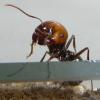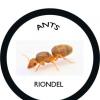- Formiculture.com
- Forums
- Gallery
- Members
- Member Map
- Chat

Excited to be here!
Started By
ben
, Apr 24 2023 4:54 PM
13 replies to this topic
#1
 Offline
-
Posted April 24 2023 - 4:54 PM
Offline
-
Posted April 24 2023 - 4:54 PM
Hello my name is ben, don’t be too distracted by my crafty username.
I have a little bit of experience with creepy crawlers from starting a worm composting bin and growing that population from less than a hundred to a couple thousand over the course of a year.
I’ve also dabbled in the intricacies of fungi culturing.
The YouTube algorithm exposed me to the anting world, when randomly on this past Saturday evening, I was shown a YouTube short of amber ants whose bellies were full of mysteriously bright red and green liquids. A few more videos later, I’m watching an Ants Canada video featuring green bellied honey pot ants raised by some guy named Drew from Cali…
Curiosity got the best of me and I had to google what these little creatures were, how they got that color, and where do they live. Turns out myrmecocystus mexicanus practically lives in my backyard in Southern NM!
Now I’m hooked.
Every bit of free time since then has been consumed by formiculture research. I know terms like gasters, brood, fully claustral, queens, nuptial flights, founding chambers, out worlds, hydrostone, ytong, water tower, test tubes…
I know they’re not the easiest to get started with but I’m doing everything I can to be ready for this summer’s nuptial flights!
What species got you hooked and when did you get your first colony started?
As a newbie, I’m open to any advice or discussion you may have for me!
I have a little bit of experience with creepy crawlers from starting a worm composting bin and growing that population from less than a hundred to a couple thousand over the course of a year.
I’ve also dabbled in the intricacies of fungi culturing.
The YouTube algorithm exposed me to the anting world, when randomly on this past Saturday evening, I was shown a YouTube short of amber ants whose bellies were full of mysteriously bright red and green liquids. A few more videos later, I’m watching an Ants Canada video featuring green bellied honey pot ants raised by some guy named Drew from Cali…
Curiosity got the best of me and I had to google what these little creatures were, how they got that color, and where do they live. Turns out myrmecocystus mexicanus practically lives in my backyard in Southern NM!
Now I’m hooked.
Every bit of free time since then has been consumed by formiculture research. I know terms like gasters, brood, fully claustral, queens, nuptial flights, founding chambers, out worlds, hydrostone, ytong, water tower, test tubes…
I know they’re not the easiest to get started with but I’m doing everything I can to be ready for this summer’s nuptial flights!
What species got you hooked and when did you get your first colony started?
As a newbie, I’m open to any advice or discussion you may have for me!
- ANTdrew, Manitobant, M_Ants and 3 others like this
#2
 Offline
-
Posted April 24 2023 - 7:16 PM
Offline
-
Posted April 24 2023 - 7:16 PM
Welcome to the forum! M. mexicanus is definitely a very cool species. For me it was a large Camponotus queen I found over 5 years ago.
- ANTdrew likes this
Leave the Road, take the Trails - Pythagoras
Utah Ant Keeping --- Here
DIY Formicariums and Outworlds --- Here
Honeypot Ant Journal --- Here
Photo Album --- Here
Videos --- Here
#3
 Offline
-
Posted April 24 2023 - 8:12 PM
Offline
-
Posted April 24 2023 - 8:12 PM
For me it was the cryptic Stigmatomma pallipes. I'd kept ants previously before them, but I'd never gone so in depth on a species before. I really need to update my careguide on Stigmatomma because I have so much good information on them now that'd be nice for anyone here who wants to shoot their shot with them😁.Hello my name is ben, don’t be too distracted by my crafty username.
I have a little bit of experience with creepy crawlers from starting a worm composting bin and growing that population from less than a hundred to a couple thousand over the course of a year.
I’ve also dabbled in the intricacies of fungi culturing.
The YouTube algorithm exposed me to the anting world, when randomly on this past Saturday evening, I was shown a YouTube short of amber ants whose bellies were full of mysteriously bright red and green liquids. A few more videos later, I’m watching an Ants Canada video featuring green bellied honey pot ants raised by some guy named Drew from Cali…
Curiosity got the best of me and I had to google what these little creatures were, how they got that color, and where do they live. Turns out myrmecocystus mexicanus practically lives in my backyard in Southern NM!
Now I’m hooked.
Every bit of free time since then has been consumed by formiculture research. I know terms like gasters, brood, fully claustral, queens, nuptial flights, founding chambers, out worlds, hydrostone, ytong, water tower, test tubes…
I know they’re not the easiest to get started with but I’m doing everything I can to be ready for this summer’s nuptial flights!
What species got you hooked and when did you get your first colony started?
As a newbie, I’m open to any advice or discussion you may have for me!
- antsinvirgina likes this
Keeps:
1:Pogonomymex occidentalis
4: Tetramorium immigrans
2 Reticulitermes flavipes
#4
 Offline
-
Posted April 24 2023 - 8:33 PM
Offline
-
Posted April 24 2023 - 8:33 PM
Welcome to the forum! M. mexicanus is definitely a very cool species. For me it was a large Camponotus queen I found over 5 years ago.
Wow yeah those guys get pretty huge!
For me it was the cryptic Stigmatomma pallipes. I'd kept ants previously before them, but I'd never gone so in depth on a species before. I really need to update my careguide on Stigmatomma because I have so much good information on them now that'd be nice for anyone here who wants to shoot their shot with them.
Those look very unique! What is it that got you to go in depth about them? You should definitely update the guide, I'd love to see what you have to say.
#5
 Offline
-
Posted April 24 2023 - 8:48 PM
Offline
-
Posted April 24 2023 - 8:48 PM
Welcome. ![]() Glad you liked my honeypot ants in that video. I actually still have that colony to this day. In July, it will be eight years old.
Glad you liked my honeypot ants in that video. I actually still have that colony to this day. In July, it will be eight years old.
- VenomousBeast, ANTdrew and AntsCali098 like this
#6
 Offline
-
Posted April 24 2023 - 9:07 PM
Offline
-
Posted April 24 2023 - 9:07 PM
Welcome.
Glad you liked my honeypot ants in that video. I actually still have that colony to this day. In July, it will be eight years old.
Wow that’s amazing! I’m slowly working through your journals so I’m not quite caught up yet on their status haha. Must have lucked out on some great genetics and your care for them must be unparalleled.
I have so many questions but I promise I’ll read through your journals first haha
#7
 Offline
-
Posted April 24 2023 - 9:08 PM
Offline
-
Posted April 24 2023 - 9:08 PM
They were super common in my area, at least, common enough to do lots of trials on them. They're also interesting looking and rather large compared to most of my native ants besides Camponotus and Formica. I've always loved the primitive ants. They also have a very unique lifestyle and behavior of feeding off the blood (hemolymph) of their larvae to obtain necessary nutrients.Wow yeah those guys get pretty huge!
Welcome to the forum! M. mexicanus is definitely a very cool species. For me it was a large Camponotus queen I found over 5 years ago.Those look very unique! What is it that got you to go in depth about them? You should definitely update the guide, I'd love to see what you have to say.
For me it was the cryptic Stigmatomma pallipes. I'd kept ants previously before them, but I'd never gone so in depth on a species before. I really need to update my careguide on Stigmatomma because I have so much good information on them now that'd be nice for anyone here who wants to shoot their shot with them.
- ANTdrew and antsinvirgina like this
Keeps:
1:Pogonomymex occidentalis
4: Tetramorium immigrans
2 Reticulitermes flavipes
#8
 Offline
-
Posted April 24 2023 - 9:43 PM
Offline
-
Posted April 24 2023 - 9:43 PM
#9
 Offline
-
Posted April 24 2023 - 10:20 PM
Offline
-
Posted April 24 2023 - 10:20 PM
Hello Ben, Welcome to Formiculture. As a new ant keeper, I offer the following suggestions to help you have an enjoyable ant keeping experience.
Be patient. This is really the best advice I can offer. It's hard to resist the temptation to look at a queen in a test tube every five minutes, but I think they do best when left on their own in a dark place. You can estimate how long it will take a queen to raise a batch of nanitics, so I leave mine undisturbed for that period. I've never seen a queen eat cocoons or workers when disturbed but some will eat eggs and brood if bothered too early. You will have disappointments, queens will die, colonies will fail to thrive, ants will drown but you will also have many successes. It was a real thrill for me when I saw the first nanitic raised by a queen that I had caught and put in a test tube. She was a Camponotus queen and only raised six nanitics that first season. I still have that colony and have added many more to my stable, each one is special to me and I find keeping them very rewarding. It all takes time and you have to be patient.
Observe your colonies. Try to not only look at your ants but to truly observe them. By that I mean, watch their behavior and observe how they react to stimuli like food, watch how their need for protein fluctuates as brood develops and this will help you get a feeling for the stage the brood is at and relate that to other colonies that you have, without actually looking at them, by observing their behavior compared to your observation colony. I have three "observation colonies". One is Camponotus, one is Lasius and one is Myrmica. These are the only three colonies that I check the brood on a regular basis (almost daily) and they have gotten quite used to being observed and are very calm about it. I try to relate what I observe in these colonies to the other colonies I have, without disturbing them all. I think ants do best when left to their own devices in a dark nest. Checking ant nests sporadically only disturbs them and causes nest disruption. This seems to be especially true with young colonies and founding queens. Keep notes on what you observe and record important dates like when you put Queen #8 in her test tube. You can help other ant keepers by writing a journal(s) in this forum and share what you have learned. None of us knows everything so we learn from each other. Read the journals, questions and answers on Formiculture and educate yourself.
Be prepared. I carry a couple of small bottles in my pocket wherever I go, just in case a queen passes in front of me as I'm going about life (it's happened more than once). Be ready when opportunities arise. I found my first Camponotus colony living in an attaché case that I had thrown on a to-be-burned pile a couple of years before. I've found small colonies while splitting firewood. I always keep an empty formicarium on stand-by for just such an opportunity. Make up test tubes with water and cotton before you go looking for queens. That way you won't have to scramble to put them together because you've got ten queens going crazy in a jar.
To summarize - Educate yourself about ants and ant keeping. Be prepared for opportunities when they arise. Observe your colonies without undue disruption and be patient as you watch your colonies grow. Good Luck!
RPT
- ben likes this
My father always said I had ants in my pants.
#10
 Offline
-
Posted April 24 2023 - 11:06 PM
Offline
-
Posted April 24 2023 - 11:06 PM
Hi there!
#11
 Offline
-
Posted April 25 2023 - 2:06 AM
Offline
-
Posted April 25 2023 - 2:06 AM
For me it was, and still is, the Crematogaster genus. They embody the quintessential essence of what an ant is, in my opinion.
Welcome to FC and this crazy hobby!
Welcome to FC and this crazy hobby!
- ben likes this
"The ants are a people not strong, yet they prepare their meat in the summer." Prov. 30:25
Keep ordinary ants in extraordinary ways.
Keep ordinary ants in extraordinary ways.
#12
 Offline
-
Posted April 25 2023 - 6:56 AM
Offline
-
Posted April 25 2023 - 6:56 AM
Hello and welcome! For me it was when I saw a large colony of a parasitic Formica genus a vacation, and put around ten of them in a container full of sand( this was a few years ago) and brought them back to my house where I researched how to care for them, and finally watched an antscanada video all about how to catch and care for Queen ants. After that I was really excited for nuptial flights, and the rest is history. ![]()
#13
 Offline
-
Posted April 25 2023 - 7:14 AM
Offline
-
Posted April 25 2023 - 7:14 AM
I originally got hooked by solenopsis geminata when i first saw them on the AC channel years ago, but my current favourite is polyergus mexicanus. Slave making ants are absolutely incredible.
My journals:
Polyergus Mexicanus: https://www.formicul...gs/#entry175528
Lasius minutus: https://www.formicul...cs/#entry174811
Lasius latipes: https://www.formicul...gs/#entry206449
General acanthomyops journal: https://www.formicul...yops-with-eggs/
Polyergus Mexicanus: https://www.formicul...gs/#entry175528
Lasius minutus: https://www.formicul...cs/#entry174811
Lasius latipes: https://www.formicul...gs/#entry206449
General acanthomyops journal: https://www.formicul...yops-with-eggs/
#14
 Offline
-
Posted April 25 2023 - 10:27 AM
Offline
-
Posted April 25 2023 - 10:27 AM
Hello Ben, Welcome to Formiculture. As a new ant keeper, I offer the following suggestions to help you have an enjoyable ant keeping experience.
Be patient. This is really the best advice I can offer. It's hard to resist the temptation to look at a queen in a test tube every five minutes, but I think they do best when left on their own in a dark place. You can estimate how long it will take a queen to raise a batch of nanitics, so I leave mine undisturbed for that period. I've never seen a queen eat cocoons or workers when disturbed but some will eat eggs and brood if bothered too early. You will have disappointments, queens will die, colonies will fail to thrive, ants will drown but you will also have many successes. It was a real thrill for me when I saw the first nanitic raised by a queen that I had caught and put in a test tube. She was a Camponotus queen and only raised six nanitics that first season. I still have that colony and have added many more to my stable, each one is special to me and I find keeping them very rewarding. It all takes time and you have to be patient.
Observe your colonies. Try to not only look at your ants but to truly observe them. By that I mean, watch their behavior and observe how they react to stimuli like food, watch how their need for protein fluctuates as brood develops and this will help you get a feeling for the stage the brood is at and relate that to other colonies that you have, without actually looking at them, by observing their behavior compared to your observation colony. I have three "observation colonies". One is Camponotus, one is Lasius and one is Myrmica. These are the only three colonies that I check the brood on a regular basis (almost daily) and they have gotten quite used to being observed and are very calm about it. I try to relate what I observe in these colonies to the other colonies I have, without disturbing them all. I think ants do best when left to their own devices in a dark nest. Checking ant nests sporadically only disturbs them and causes nest disruption. This seems to be especially true with young colonies and founding queens. Keep notes on what you observe and record important dates like when you put Queen #8 in her test tube. You can help other ant keepers by writing a journal(s) in this forum and share what you have learned. None of us knows everything so we learn from each other. Read the journals, questions and answers on Formiculture and educate yourself.
Be prepared. I carry a couple of small bottles in my pocket wherever I go, just in case a queen passes in front of me as I'm going about life (it's happened more than once). Be ready when opportunities arise. I found my first Camponotus colony living in an attaché case that I had thrown on a to-be-burned pile a couple of years before. I've found small colonies while splitting firewood. I always keep an empty formicarium on stand-by for just such an opportunity. Make up test tubes with water and cotton before you go looking for queens. That way you won't have to scramble to put them together because you've got ten queens going crazy in a jar.
To summarize - Educate yourself about ants and ant keeping. Be prepared for opportunities when they arise. Observe your colonies without undue disruption and be patient as you watch your colonies grow. Good Luck!
RPT
Thank you for the newbie tips! It will be hard for me to leave the founding queens alone, but I know it’s for the best. It was the same with the worms, when I wanted to check on them to see if they were alright. But as you can imagine, they don’t like being dug up lol.
I’ll plan on having an observation colony or two that I’ll be able to show to any curious enough guests and experiment with, that’s great advice thank you!
- rptraut likes this
1 user(s) are reading this topic
0 members, 1 guests, 0 anonymous users
























